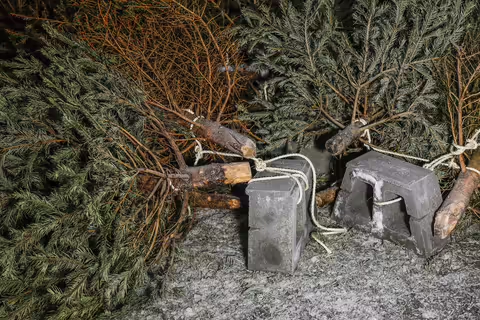URBANA, Ill. – Once holidays are over, the Christmas trees tend to come down. Instead of hauling this year’s tree to the dump or having the city pick it up, consider repurposing it in your landscape.
University of Illinois Extension Horticulture Educator Ken Johnson says one popular use for Christmas trees after the holidays is to use them to block wind that can hinder feeding birds.
“Trees can be used as a windbreak by placing them to the northwest of feeders to block where our prevailing winds come from this time of year,” Johnson says. “Not only will this help protect birds from the wind as they feed, but it can also prevent birdseed from blowing out of feeders.”
Additionally, trees can be turned into a large festive bird feeder. Anchor the tree to the ground using a steel fence post. Then decorate it with strings of popcorn and/or cranberries, as well as pinecones smeared with peanut butter and sunflower seeds, suet, or chopped fruit in a mesh bag.
“Christmas trees can also be used to create habitat for other wildlife in the form of brush piles,” Johnson says. “Place brush piles near field borders and in woodland areas along with other brush to provide cover for wildlife.”
Before building a brush pile, check for local ordinances that may prohibit them.
Another use for your Christmas tree includes providing habitat for aquatic wildlife. Trees can be sunk in ponds to provide shelter for fish and other aquatic life. A single tree won’t offer much habitat, so it’s best to group three or four together. Trees should be sunk vertically using rocks or concrete blocks as anchors.
In the garden, evergreen branches and needles can be used as mulches to cover perennial plants during the winter. These mulches are light and won't pack or suffocate the roots of the plants they are protecting. Trees can also be chipped and used as mulch in the garden to help reduce weed problems, moderate soil temperature and retain moisture.
“Your Christmas tree can also be a good source of wood for an outdoor fire,” Johnson says. “The branches and needles are good for getting fires started, and the trunk can be used as fuel.”
Never burn a Christmas tree in a fireplace or woodstove. It may contribute to creosote buildup and could cause a chimney fire.
Finally, trees can be used in a variety of crafty ways. The needles can be used to make potpourri. When dry, the trunk can be cut into wooden discs and used as coasters or trivets, used to edge garden beds, or decorated and turned into ornaments.
Regardless of how a tree is reused after the holidays, make sure to remove all ornaments and tinsel.
SOURCE: Ken Johnson, Horticulture Educator, University of Illinois Extension
ABOUT EXTENSION: Illinois Extension, the public outreach and engagement arm of the University of Illinois, translates research-based knowledge into actionable insights and strategies that enable Illinois businesses, families, and community leaders to solve problems, adapt to changes and opportunities, make informed decisions, and carry technical advancements forward into practice.
